|
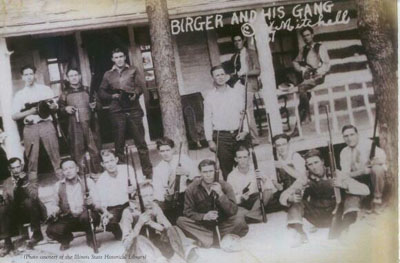
BOOTLEGGING IN ILLINOIS
bathtub gin and the whole shootin' match
by Nancy Nixon
A squeal of tires and the
roar of engines. Terrified
mothers and children
hide as several men,
dressed in tailored suits,
dark trench coats and fedoras,
wielding machine guns, storm a
warehouse. Gunfire breaks out,
and in less than a minute, it's
all over. The death toll is three,
and two others are badly injured. With their job fulfilled
the men dash to their cars and
speed away into the dark shroud
of night.
For Illinoisans, this probably sounds like the olden days
in Chicago — but gangster activity stemming from alcohol bootlegging operations was just as cornmonplace in downstate Illinois during the Prohibition period.
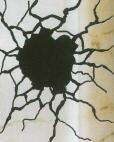
"There would be no quenching
the insatiable demand for booze in
the big cities, and in many of the
smaller towns too," writes Taylor
Pensoneau, author of a soon-to-be-published book, detailing the activities of notorious southern
Illinois bootleggers, the Shelton
Gang, which will be published
later this year. "For the most part,
though, the far-flung market for liquor-triggered illegal production
and distribution systems blanketed
virtually every part of America.
Lawless or not,
these operations turned
profits like
any other
large business, only often
greater. Of
course, most of
the dough
ended up in the pockets of
organized crime, which
wound up pretty much running the whole illicit show."
The 18th Amendment to the
U.S. Constitution, which was
ratified in 1919, prohibited the
manufacture and sale of alcohol.
10 ILLINOIS COUNTRY LlVING•April 2001
The gross neglect of enforcing the
Amendment gave widespread, illegal bootlegging carte blanche
throughout Illinois. Many a farmer
and businessman made his own
private stash of "bathtub gin," as it
was called, but that wasn't where
the money was. The allure of the
profits from large scale
bootlegging, or the illegal
manufacture, transportation or distribution of
alcohol, fostered the
development of a new type of criminal,
the gangster, which
led to more than a
decade of turf wars and
murders. "For the Sheltons, for AlCapone in Chicago, and for many
others, Prohibition was their gold
rush," writes Pensoneau. And this
set the stage for one of the most intriguing periods in Illinois history.
Chicago was the headquarters
for the illicit bootlegging activity of
mob boss Al Capone and his gang.
He held a tight rein on any buying,
selling or transporting of alcohol
in a territory that reached southward to just below Peoria, and
sometimes further south. Henry
"Kelly" Wagle of Colchester,
known as the most notorious man
in McDonough County, supplied
most of the hard liquor sold in the
county and nearby areas. Wagle
was acquainted with Capone and
hauled his liquor from Chicago.
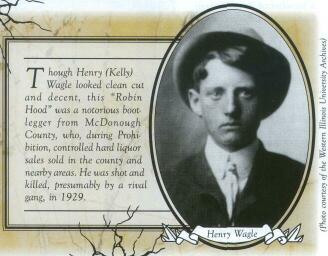
Wagle, like many bootleggers,
was considered a sort of "Robin
Hood." While he was a known
bootlegger, that was overlooked to
a degree because he also did good
deeds for the local people and
helped to keep a lid on petty
crime. But, he was also quite bold.
One particular story details that in
1926 or 1927, the Christian
Church in Colchester converted
from coal to oil heat, leaving a
large coal bin empty in the basement. Supposedly, Wagle acquired
access to the bin and stored liquor
there. Once the rumor got out, of
course, the liquor was removed.
The Ku Klux Klan waged a war
on bootleggers. The Klan had been
formed with a common purpose to
bring back what they called "decency" and to rid those engaged in
"improper behavior," using whatever tactics they felt were necessary.
Although they had the support of
many churches, they abhorred foreigners, Jews and Catholics. The
Klan had grown to some
200,000 by the mid-1920s, and was gaining
power in and around
McDonough County.
The Klan was a constant
thorn in Wagle's
side, and he even
had a cross
burned on his
property one night.
On April 8, 1929
Wagle was shot and killed gangland style, or "with his boots on,"
as it was called. Although his killer
was never found, it was said that
Wagle's murder was most likely ordered by a rival gang.
Located around 30 miles south
of Colchester, the small town of
Beardstown was known as a refuge
for gang members who needed to
leave Chicago "in a hurry" during
the Prohibition days.
"I lived in Beardstown from
1921 on and it was pretty well
known that many bootleggers in
the Al Capone era came down
when the heat was on," says Pharmacist Ed Lewis, now a resident of
Canton. "They lived on houseboats on the Illinois River and
they had unusual built-in burglar
alarms. When the frogs stopped
croaking, they knew someone was
approaching."
Lewis continues, "The gangs
would take anywhere from a two-
week to a month-long vacation and
enjoy the local sports of fishing
and duck hunting."
Morris Bell, a former board
member of Menard Electric
Cooperative and the Association of Illinois Electric
Cooperatives, backs up
that story. "Locals known as 'pushers' would take Al Capone and his
people out to the prime hunting locations in the area around Snicarte
and Bath and teach them how to
hunt. If the gang members didn't
shoot any ducks on their own, the
pushers would kill some so the
gangsters could go back to Chicago
and gloat about their 'catch.'"
Frank McErlane, known as the
meanest gangster in Chicago and
loyalist to Al Capone, actually died
in Beardstown. After Capone was
sent to prison, McErlane became a
drunk, and his south side Chicago
associates, fearing for his life, arranged for him to live on a lavishly
furnished houseboat on the Illinois
APRIL 2001•
ILLINOIS COUNTRY LIVING
11
River. Unlike most of his gangland
associates, McErlane died "with his
boots off' on October 8, 1932 at
Beardstown's Schmitt Memorial
Hospital. After a rather unceremonious funeral (by ganster standards), he was buried
Sepulcher Cemetery in Chicago.
Many a poor
farmer turned to boot
legging as a source of
income. Auburn resident Felix Marchizza,
a member of Rural Electric
Convenience Cooperative,
Auburn, was born and
raised in southern Illinois'
Franklin County, and remembers bootlegging well. He says
that in the 1930s, he was a
young boy in about the second
grade. His dad was a coal
miner and the family barely
lived from day to day, so bootlegging kept food on their
table. Once, when an officer arrested him and threatened to
put him in jail he retorted,
"You can do that, but you'll
have to feed my family."
"My dad did a lot of bootlegging," Marchizza says. "We
kept the still in the shed or in
the basement, depending on
where we lived at the time." He
adds, "My dad's buddy had a
big still set up in his barn and we
sold moonshine to the Mafia in
Chicago. They bought it a truckload at a time. They'd come down
south in their Model T- and Model
A-trucks, and men with machine
guns would stand guard while they
were loading up."
When asked what he thought
of the Mafia back then, Marchizza
replies, "Heck, we couldn't wait for
them to come. We were so poor we
couldn't afford to buy candy, so
whenever they came down, the Mafia members would bring all the
kids candy."
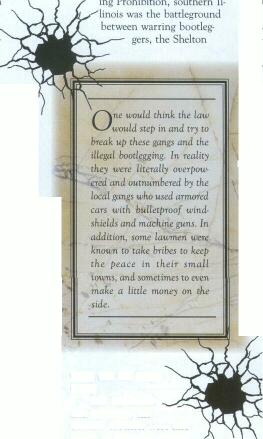
Phillip Trammel, a resident of
Stonefort, in southern Illinois, can
also remember bootlegging in his
area. He says one of his neighbors
had seven stills that were kept in
the basement, and when he died,
they were auctioned off illegally.
He had another neighbor who
made his own wine and used it to
pickle his beets. "Those were the
best beets I ever ate," says Trammel.
For a number of years, during Prohibition, southern Illinois was the battleground
between warring bootleggers, the Shelton Gang and the Birger
Gang.
Like Marchizza and Trammel, the
Shelton brothers were also
raised in southern Illinois.
Of the five brothers, only
three, Carl, Earl and Bernie comprised the Shelton Gang. After
stints in prison for various crimes,
Carl and Earl worked in Illinois
mines and with Bernie, they returned to East St. Louis, where
they had previously worked, and
began running lucrative gambling
houses and bootlegging establishments. In the early 1920s their
bootlegging operation expanded
into the southern Illinois counties
According to Pensoneau, Carl
Shelton supposedly said, "There
ain't a little town around here
that's not gonna miss its whiskey.
These farmers may vote dry on
election day, but they drink wet on
Saturday night. We can run
enough rum up here from the Bahamas to flood all of Little Egypt
(southern Illinois)."
In 1923, Carl Shelton met
Shashna Itzik (Charlie) Birger, a
Russian Jew, in a Herrin hospital,
and they became personal friends
and business associates in
both bootlegging and the slot-machine racket, which they all
but monopolized. They
teamed up against the Ku Klux
Klan, who by then had overwhelmed the area. This relationship would be short lived,
and in fact, their feud would
become one of Illinois' great
rivalries of the Prohibition era.
It all started when Earl
Shelton learned that Charlie
Birger had milked $3,000
from their joint 50-50 slot-machine partnership, for his
"protection." The Shelton
Gang felt betrayed and banished Birger from the business. At around that same
time, Birger became enraged
when the Shelton brothers
wouldn't help smuggle some of
his Russian relatives into
Florida.
The loyalty the
two gangs had once
enjoyed was now replaced with mistrust and
disdain, and from that
point on it was war, with
bombings and shootings a
regular occurrence. Both
gangs operated from behind an arsenal of ammunition. There wasn't
a safe place in southern Illinois
during the war between the two
gangs. If innocent by-standers happened to be at the wrong place at
the wrong time, they could be
caught in the line of fire and killed
along with the intended targets.
The Shelton Gang didn't have a
fixed headquarters, making them
harder to locate, but Birger had a
lavish roadhouse, known as Shady
Rest, where "bathtub gin flowed
like water," which was their rival
12
ILLINOIS COUNTRY LIVING•
APRIL 2001
gang's favorite target from land
and air.
One would think the law
would step in and try to break up
these gangs and the illegal
bootlegging. In reality they
were literally overpowered
and outnumbered by the local gangs who used armored
cars with bulletproof windshields and machine guns.
In addition, some lawmen
were known to take bribes
to keep the peace in their
small towns, and sometimes
to even make a little money
on the side.
If one of the gangs antagonized the other, the rival
gang would take revenge,
and vice-versa. As soon as
Birger would make a liquor
delivery to a roadhouse (illegal drinking establishment),
the Shelton gang would
come right after him and
shoot up the business.
Birger would retaliate, and
this violent bombardment
became a way of life in
southern Illinois. The gang
war escalated when, on November 9, 1926, Birger's beloved hideout was thought
to have been bombed and
destroyed by Shelton's men, leaving only smoldering ashes and four
charred bodies in the aftermath.
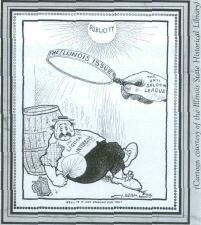
This Cartoon depicts the great
pressure exerted by the anti-alcohol faction over the manufactures and distributors of alcohol, which resulted in the
18th Amendment to the Constitution, known as Prohibition.
|
Birger swore revenge, and his
final act against the Shelton Gang
was to have Joe Adams, the mayor
of West City, and a Shelton sympathizer, murdered. Birger was tried,
convicted and sentenced to hang
for the murder. Although Birger
was a vicious killer who would take
a life in an instant, he was beloved by the locals, who appreciated his acts of generosity and
local protection. On April 19,
1928, as he was being led to the
gallows, Birger calmly smiled,
shook the executioner's hand and
was quoted as saying, "It's a beautiful world."
Shortly after Birger's death, in
1933, the Prohibition Amendment
was repealed and alcohol
flowed legally again, putting
most bootleggers out of business. The killings continued,
however, as nearly 50 members of the Shelton Gang
were either murdered or
died under inexplicable circumstances within a 20-year
time span.
Today, some evidence of
the Prohibition era still exists in Illinois. Bootlegging
continues in some areas of
the state, while some counties are dry, meaning alcohol
can't be sold there. And
some people are hesitant
even today to speak freely
about the bootlegging activity that occurred in their areas. Pensoneau says, "There
is still lingering apprehension in some places about
these scenarios played out so
many decades ago."
We can only speculate
about the stories that
were carried to the
grave with those who
lived and maybe even
took part in the illegal activities back then, but we do
know one thing. The Prohibition
era has indelibly marked a compelling and mysterious chapter in the
book of Illinois' history.
|
More information about Prohibition and bootlegging in Illinois can be found at the Illinois
State Historical Library, Old State Capitol Building, Springfield, Illinois, 62701, (217)
785-7955; the Western Illinois University Archives, at (309) 298-2717; and at several Internet
web sites: www.britannica.com; encarta.msn.com; www.americanmafia.com;
www.egyptianaaa.org/SI-History3.htm; www.springhousemagazine.com; www.hallmemoirs.com.
Books relating to the subject are: The Bootlegger, by John Hallwas, The Era of Excess, by
Andrew Sinclair, Prohibition: The: Lie of the Land, by Sean Dennis Cashman, and Taylor
Pensoneau's book about the Shelton Gang, which will be completed later this year. Pensoneau
can be reached at the Illinois Coal Association at (217) 528-2092.
|
APRIL 2001•
ILLINOIS COUNTRY LIVING
13
|

